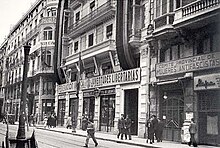Federación Ibérica de Juventudes Libertarias
The Federación Ibérica de Juventudes Libertarias ( FIJL ) was an anarchist youth federation that was founded in Madrid in 1932 during the Second Spanish Republic . She was also known under the name Juventudes Libertarias ( JJLL ). After the defeat of the libertarian movement in the Spanish Civil War , the FIJL was active as an exile organization mainly in France until 1973 .
Foundation and civil war
At the founding congress of the FIJL, which took place between August 18 and 22, 1932 in Madrid, three variants of an organizational self-image were discussed: as a section for culture and propaganda within the Federación Anarquista Ibérica (FAI), as a youth organization of the Confederación Nacional del Trabajo (CNT) or as an independent youth association. The latter position eventually prevailed. In the following years the federation established itself nationwide and became the third pillar of the libertarian movement alongside the CNT and FAI. One of the founding members of the FIJL was José Peirats .
After the outbreak of the Spanish Civil War in the summer of 1936, a fundamental controversy arose within the libertarian movement over the question of whether priority should be given to anti-fascist unity or the continuation of the social revolution . The regional federation of the FIJL in Catalonia entered into a revolutionary alliance in February 1937 against the increasing influence of Stalinism within the anti-fascist camp. The youth association of the Partido Obrero de Unificación Marxista (POUM) as well as parts of the united youth association of the Partido Socialista Obrero Español (PSOE) and the Partido Comunista de España (PCE) also took part. As a result, tensions rose and culminated in the May events . Together with the anarchist group Amigos de Durruti and the left-wing socialists of the POUM, many members of the JJLL took up arms in May 1937. After the conflict ended, numerous opponents of Stalinism were murdered by the Gossudarstvennoje polititscheskoje uprawlenije (GPU), including Camillo Berneri and the secretary of the JJLL Alfredo Martínez.
Members of the FIJL formed the Batallón Juvenil Libertario in Madrid during the civil war . In addition, numerous members fought in various anarchist militias, such as the Columna de Hierro . Robert Capa may have captured the death of FIJL activist Federico Borrell García in his famous photograph Loyalist Soldier at the moment of his death .
In February 1937 a meeting of delegates of the FIJL took place in Valencia . The delegates spoke for 82,221 members. In the last phase of the civil war, the FIJL merged with the CNT-FAI to form an organizational association, the Movimiento Libertario Español (MLE).
Exile and decline
After the defeat in the civil war in 1939, the MLE was divided: in Spain the structures were taken underground. Several waves of arrests forced regular restructuring and increasingly weakened the organization. After the Second World War, there were many hopes of an Allied invasion of Spain. These hopes were dashed with the arrangement of the Western powers with the Franco regime at the beginning of the Cold War . At the end of the 1950s, the libertarian movement in Spain was barely able to act.
At the same time, the exile organization was mainly active in France. In exile, the FIJL increasingly assumed the role that the FAI had in the 1920s and 1930s, i.e. H. she campaigned for an uncompromising, purely anarchist orientation of the libertarian movement. Outstanding activists of the libertarian youth during this period included Luís Andrés Edo and Abel Paz .
At a congress in Limoges in 1961 , the founding of a clandestine organization called Defensa Interior (DI) was decided to carry out resistance actions in Spain. They carried out dozens of bomb attacks and planned attacks on Francisco Franco , but all of them failed. Tensions arose between the FIJL and the CNT over the question of whether such actions could destabilize the Francoist regime. As a result, the armed resistance groups operated under different names (including Grupo Primero de Mayo ).
In France, the JJLL organized annual summer camps in the 1960s where a new generation of libertarian activists from different European countries got to know each other. The FIJL supported the strike movement and uprisings in France in May 1968 . The neo-anarchism that emerged from these events was, however, incompatible with the classic organizational concepts of anarchism. The consequence was the decline and finally the dissolution of the FIJL in 1973. Several attempts after the end of Franquism in 1977 to establish a Spain-wide federation of libertarian youth groups as a successor organization failed.
Movie
- Assassinations on Franco - resistance against a dictator by Daniel Guthmann and Joachim Palutzki. 44 minutes, production: Second German Television , Germany 2016.
literature
- Luís Andrés Edo: La CNT en la encrucijada. Aventuras de un heterodoxo . Flor del Viento, Barcelona 2006, ISBN 84-96495-14-0 , ( Tramontana 16), (autobiography).
- Miguel Ìñiguez: Esbozo de una Enciclopedia histórica del anarquismo español. FAL, Madrid 2001, ISBN 84-86864-45-3 , p. 227.
- Heleno Saña : The Libertarian Revolution. The anarchists in the Spanish Civil War . Edition Nautilus, Hamburg 2001. ISBN 3-89401-378-8 .

